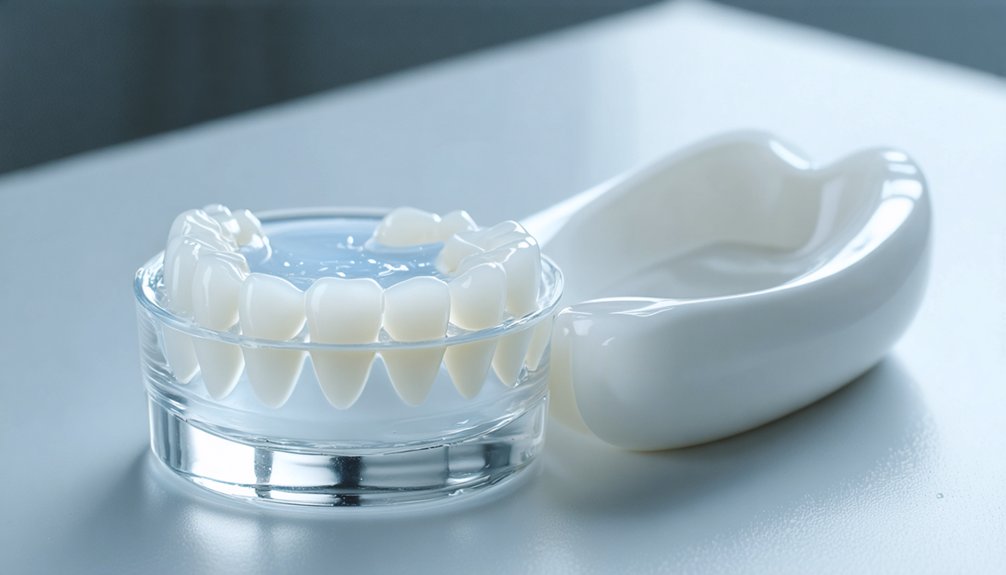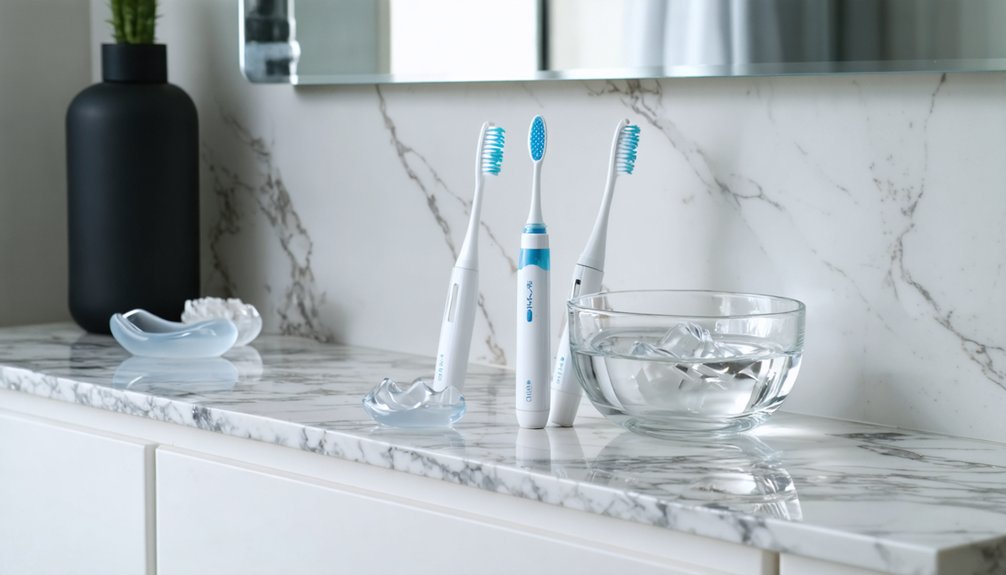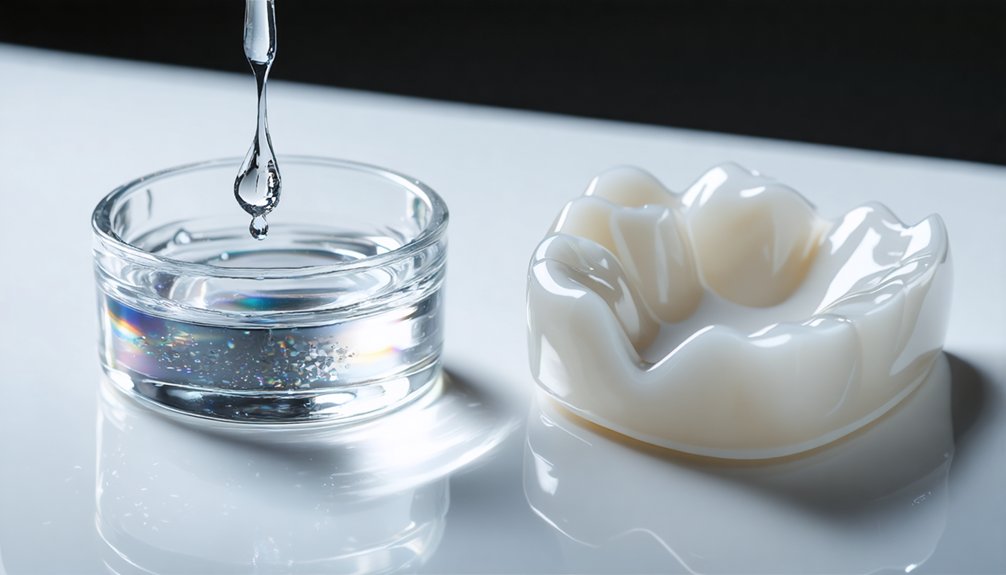For sensitive teeth, you’ll get the best whitening results using gels with 10-15% carbamide peroxide or 6-10% hydrogen peroxide combined with potassium nitrate and fluoride. These lower concentrations minimize discomfort while effectively brightening teeth. Choose products like Pola or Philips Zoom that specifically target sensitivity, and apply for shorter 15-20 minute sessions initially. Following proper application techniques and incorporating desensitizing agents can transform your whitening experience from uncomfortable to successful.
Key Takeaways
- Choose whitening gels with 10-15% carbamide peroxide or 6-10% hydrogen peroxide concentration for gentle yet effective whitening results.
- Look for products containing both potassium nitrate and fluoride to minimize sensitivity while protecting and strengthening tooth enamel.
- Start with short 15-20 minute treatment sessions and gradually increase duration to minimize discomfort and sensitivity.
- Use desensitizing toothpaste for 1-2 weeks before starting whitening treatment to prepare teeth and reduce potential sensitivity.
- Consider brands like Pola or Philips Zoom that offer lower-strength formulations specifically designed for sensitive teeth.
Understanding Tooth Sensitivity During Whitening
While teeth whitening remains a popular cosmetic dental procedure, it often triggers temporary sensitivity due to the mechanism of peroxide-based bleaching agents.
When you apply whitening products containing hydrogen peroxide or carbamide peroxide, they release oxygen molecules that penetrate your tooth enamel to break down stain molecules.
This process causes enamel demineralization, increasing porosity and exposing the underlying dentinal tubules that connect to your tooth’s nerve endings.
You’ll typically experience sharp, sudden sensations called “zingers,” particularly when consuming hot or cold substances.
The severity of tooth sensitivity varies based on your enamel thickness, treatment duration, and peroxide concentration. If you experience severe sensitivity, professional intervention may be necessary to provide immediate relief.
While uncomfortable, this sensitivity is usually temporary and subsides as your teeth naturally remineralize after treatment completion, with the dentinal tubules gradually resealing themselves. Modern anti-sensitivity toothpaste products like Sensodyne can help minimize discomfort during the whitening process.
Key Ingredients That Combat Sensitivity
Your teeth’s sensitivity during whitening can be effectively managed through two essential ingredients: potassium nitrate and fluoride.
Potassium nitrate works by calming the nerve endings in your dentin, reducing the sharp pain and tingling sensations commonly experienced during whitening treatments. Understanding that tiny pores exist in teeth leading to nerve endings helps explain why these ingredients are crucial.
Fluoride strengthens your enamel throughout the whitening process, creating a protective barrier that limits peroxide penetration while supporting remineralization of the tooth surface. These ingredients work best when formulated with lower peroxide concentrations to minimize potential tooth sensitivity while still achieving effective whitening results.
Potassium Nitrate Benefits Explained
When dental sensitivity disrupts your daily life, potassium nitrate (KNO₃) emerges as a clinically proven solution for managing tooth discomfort. This active ingredient works by diffusing into exposed dentin tubules and reaching nerve endings in your tooth pulp, where it effectively blocks pain signals.
You’ll notice the desensitizing effect develops gradually as potassium ions accumulate, reducing nerve excitability and responsiveness to external stimuli. Regular brushing with potassium nitrate creates a protective shield for teeth, helping maintain long-term relief. The low abrasive formula ensures minimal wear on exposed dentin, which is significantly softer than tooth enamel.
Clinical studies confirm that both 5% potassium nitrate toothpaste and 3% mouthwash formulations markedly decrease sensitivity. While you’ll need to use these products consistently for about two weeks to experience full benefits, the relief is substantial when incorporated into your daily oral care routine.
Remember that continuous use is essential, as sensitivity may return if treatment is discontinued.
Fluoride Protection During Whitening
Since fluoride plays an essential role in protecting sensitive teeth during whitening treatments, understanding its mechanisms can help optimize your results.
Fluoride benefits include accelerating enamel remineralization by attracting calcium and phosphate minerals to weakened tooth structure. This strengthening process creates a protective barrier that reduces nerve exposure and sensitivity.
You’ll find fluoride delivered through multiple effective methods: professional varnishes and gels applied immediately after whitening sessions, specialized toothpaste formulations, and therapeutic mouth rinses. The American Dental Association recommends using ADA-accepted fluoride toothpaste to help rebuild and strengthen tooth enamel after whitening procedures. Using desensitizing toothpaste regularly can provide additional protection against sensitivity during the whitening process.
Key fluoride compounds like sodium fluoride, stannous fluoride, and monofluorophosphate work to seal dentinal tubules and fortify enamel.
When combined with staged whitening protocols, fluoride treatments greatly decrease sensitivity frequency and severity while maintaining whitening efficacy, making them essential for your patients’ comfort and results.
Choosing the Right Whitening Gel Strength
The selection of appropriate whitening gel strength represents a critical decision for individuals with sensitive teeth. When comparing whitening gel types, you’ll encounter two primary options: hydrogen peroxide and carbamide peroxide. Colgate offers gentle concentration levels that work well for beginners starting their whitening journey.
Choosing the right whitening gel concentration matters greatly for sensitive teeth, with hydrogen peroxide and carbamide peroxide being the main options available.
For sensitive teeth, start with lower concentrations – around 10-15% carbamide peroxide or 6-10% hydrogen peroxide – to minimize discomfort while achieving gradual results. The 16% hydrogen peroxide formulation offers an excellent balance of gentle whitening power while maintaining comfort for those with tooth sensitivity.
Understanding concentration comparisons is essential: carbamide peroxide releases hydrogen peroxide more slowly, making it ideal for at-home use, particularly overnight treatments. To convert carbamide peroxide to its hydrogen peroxide equivalent, divide by 2.7668.
While higher concentrations offer faster results, they greatly increase sensitivity risks. Consider brands like Pola or Philips Zoom’s lower-strength options, which include desensitizing properties specifically designed for sensitive teeth.
Best Practices for Safe Application
When applying whitening gel to your trays, you’ll achieve ideal results by carefully timing your sessions and ensuring precise tray placement against your teeth.
You should place a small amount (0.5 ml) of gel halfway up the inner front surface of each tooth compartment, avoiding contact with your gums.
For maximum safety and effectiveness, you’ll need to verify your trays fit securely before beginning treatment and maintain consistent wearing times of 20-30 minutes initially for higher concentration gels.
Timing and Tray Placement
Proper timing and tray placement play essential roles in minimizing tooth sensitivity during whitening treatments. Start with shorter 15-20 minute sessions rather than overnight applications, especially during your initial treatments.
If you’re experiencing sensitivity, implement timing adjustments by spacing sessions every other day instead of daily.
For ideal tray selection and placement, guarantee a snug fit that covers only the teeth while avoiding gum tissue. Apply approximately 0.5ml of gel halfway up the inner front surface of each tooth compartment.
Don’t overfill, as excess gel can cause gum irritation. Before applying gel, test the empty tray’s fit to confirm proper coverage.
For patients with exposed roots, apply petroleum jelly to protect gum tissue before insertion. These precise application techniques help minimize sensitivity while achieving desired whitening results.
Gentle Application Techniques
Successfully minimizing tooth sensitivity during whitening treatments requires careful attention to precise gel application techniques.
Apply a small drop of whitening gel halfway up each tooth’s front inner surface, focusing on the 6-8 most visible teeth. You’ll need approximately 0.5 ml of gel per arch for best results.
Before your gentle application, verify your trays are completely clean and dry to maximize bleaching efficiency.
Test the tray adjustment without gel first to confirm proper fit and comfort. Apply petroleum jelly to protect your gums, then carefully place single drops of gel without spreading or smearing.
Don’t fill trays completely, as excess gel can cause gum irritation and heightened sensitivity. Remove any gel that may have squeezed onto tray edges to prevent contact with sensitive tissue during treatment.
Managing Discomfort and Side Effects

Understanding the potential side effects of teeth whitening and how to manage them effectively is essential for achieving best results while minimizing discomfort.
You’ll typically experience tooth sensitivity and possible gum irritation, particularly when peroxide agents penetrate your enamel. For ideal discomfort management, use desensitizing toothpaste before and after treatments, and apply protective barriers to your gums during application.
For side effect prevention, follow application instructions precisely, avoiding prolonged exposure to whitening agents. If you’re prone to sensitivity, choose lower-concentration products and consider shorter treatment sessions.
Monitor your response carefully – while temporary sensitivity is normal, persistent discomfort or severe gum irritation requires professional evaluation. Don’t hesitate to consult your dentist if symptoms persist beyond several days or if you have pre-existing dental conditions.
Professional Vs At-Home Treatment Options
When considering teeth whitening options for sensitive teeth, you’ll need to weigh the benefits of professional treatments against at-home alternatives.
Professional guidance offers higher concentration gels (25-40% hydrogen peroxide) with customized application and immediate results under expert supervision. You’ll receive desensitizing treatments and personalized care tailored to your sensitivity levels.
Professional teeth whitening combines powerful peroxide treatments with expert care, ensuring both dramatic results and protection for sensitive teeth.
At-home options provide gentler approaches using lower concentration gels and gradual whitening processes. Product comparison reveals options like Crest 3D Whitestrips Sensitive or PAP whitening agents, which offer peroxide-free alternatives.
While professional treatments deliver faster, more dramatic results with thorough monitoring, at-home solutions provide cost-effective convenience. Your choice should balance effectiveness with comfort, considering factors like treatment speed, sensitivity management, and budget constraints.
Preventive Steps Before Starting Treatment

Before beginning any teeth whitening treatment, proper preparation can greatly reduce sensitivity and enhance results. Schedule a thorough dental evaluation to assess sensitivity triggers and identify any underlying oral health issues that could affect treatment success.
Start using desensitizing toothpaste containing potassium nitrate or fluoride 1-2 weeks prior to whitening, and incorporate calcium phosphate treatments to strengthen your enamel.
Maintain meticulous oral hygiene with soft-bristled brushing and regular flossing to guarantee ideal treatment conditions.
Make necessary dietary adjustments by avoiding acidic, hot, and cold foods that could increase sensitivity. Schedule a professional cleaning close to your whitening appointment, and don’t use over-the-counter whitening products immediately before treatment.
These preventive steps will help ensure a more comfortable and effective whitening experience.
Post-Treatment Care and Maintenance
Proper post-treatment care remains essential for maximizing whitening results while minimizing tooth sensitivity. Your post-treatment routines should include using a desensitizing toothpaste containing potassium nitrate or arginine to block pain signals.
Brush gently with a soft-bristled toothbrush and lukewarm water to protect your enamel.
To manage sensitivity triggers, avoid extreme temperature foods and beverages during the recovery period. Use a fluoride or potassium nitrate mouthwash twice daily to soothe sensitive areas and promote remineralization.
Apply desensitizing gels between whitening sessions to protect exposed dentin. For ongoing maintenance, select whitening products with low hydrogen peroxide concentrations and those specifically designed for sensitive teeth.
Consider using a straw for acidic beverages and maintain protective barriers on exposed tooth roots if sensitivity persists.
Frequently Asked Questions
Can Whitening Gels Be Used on Dental Implants or Veneers?
You can’t achieve whitening effectiveness on dental implants or veneers since these dental restorations don’t respond to bleaching agents. You’ll need professional replacement to match newly whitened natural teeth.
How Long Should I Wait After a Dental Cleaning to Start Whitening?
You don’t need to wait at all! Your sparkling clean teeth are perfectly primed for whitening immediately after your dental hygiene appointment, as your enamel’s now ideally prepared for the whitening timeline to begin.
Will Smoking or Drinking Coffee Affect Whitening Results on Sensitive Teeth?
Both smoking effects and coffee staining will impact your whitening results, but smoking causes deeper, more stubborn stains. You’ll need more frequent touch-ups if you continue these habits during treatment.
Can Pregnancy or Breastfeeding Affect Sensitivity to Whitening Gels?
Your teeth become dramatically more sensitive during pregnancy due to surging hormones that inflame gums. While breastfeeding effects are milder, it’s best to postpone whitening until after both phases for ideal comfort.
Is It Safe to Whiten Teeth While Wearing Clear Aligners?
You can safely whiten teeth while wearing clear aligners, but you’ll need aligner-compatible gels to maintain aligner durability and guarantee gel effectiveness. Consult your orthodontist for specific product recommendations and supervision.
References
- https://www.goodrx.com/conditions/dental-care/sensitive-teeth-after-whitening
- https://www.dentistryofwestbend.com/teeth-whitening-risks-and-side-effects/
- https://precisiondentalnyc.com/10-tips-for-dealing-with-sensitivity-after-teeth-whitening/
- https://buforddentist.com/what-are-the-best-whitening-options-for-sensitive-teeth/
- https://pmc.ncbi.nlm.nih.gov/articles/PMC4058574/
- https://pmc.ncbi.nlm.nih.gov/articles/PMC6787621/
- https://larrymolendadds.com/teeth-whitening-for-sensitive-teeth-is-it-safe-effective/
- https://mydetroitdentist.com/is-teeth-whitening-for-sensitive-teeth-a-safe-and-effective/
- https://harrisburgsmilesdental.com/why-does-teeth-whitening-cause-sensitivity-understanding-the-basics/
- https://tooth-doctor.com/severe-tooth-sensitivity-after-teeth-whitening/



